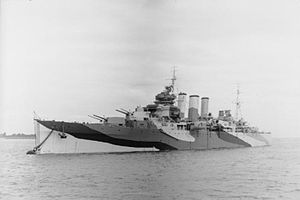HMS Shropshire

| |
| History | |
|---|---|
| Name | HMS Shropshire |
| Namesake | Shropshire, England |
| Builder | William Beardmore and Company (Dailmuir, Scotland) |
| Laid down | 24 February 1927 |
| Launched | 5 July 1928 |
| Commissioned | 12 September 1929 |
| Decommissioned | 23 December 1942 |
| Fate | Transferred to Royal Australian Navy |
| History | |
| Name | HMAS Shropshire |
| Commissioned | 20 April 1943 |
| Decommissioned | 10 November 1949 |
| Motto | "Floreat Ambo" |
| Fate | Sold for scrapping, 16 July 1954 |
| Notes | Pennant number 73 |
| General characteristics | |
| Class and type | County class heavy cruiser |
| Displacement | list error: <br /> list (help) 9,750 tons standard 13,315 tons full load |
| Length | 633 ft (193 m) |
| Beam | 66 ft (20 m) |
| Draught | 21 ft (6.4 m) |
| Propulsion | list error: <br /> list (help) Eight Admiralty 3-drum boilers Four shaft Parsons geared turbines 80,000 shp (60 MN) |
| Speed | 32 knots (59.3 km/h) |
| Range | list error: <br /> list (help) 4,715 kilometres (2,930 mi) at 31.5 knots (58.3 km/h) knots 20,116 kilometres (12,500 mi) at 12 knots (22 km/h) 3,210 tons fuel oil |
| Complement | 650 (peace), 820 (war) |
| Armament | list error: <br /> list (help) Original configuration:
|
| Armour | list error: <br /> list (help) 1 to 4 inches (2.5 to 10.2 cm) magazine box protection,
|
| Aircraft carried | One aircraft, one catapult. Three planes used during service; Fairey III, Hawker Osprey, Supermarine Walrus |
HMS Shropshire (73)[1] (later HMAS Shropshire) was a Royal Navy heavy cruiser of the London sub-class of County class cruisers. She is the only ship to have been named after Shropshire, England.
Shropshire was laid down at the shipyard of William Beardmore and Company, Limited, at Dalmuir in Scotland on 24 February 1926. She was launched on 5 July 1928 by the Countess of Powis, Baroness D'Arcy de Knayth and completed on 12 September 1929. Shropshire served with the British Mediterranean Fleet until the outbreak of war in September 1939.
War service and transfer
Her initial service in the Second World War was in operations in the South Atlantic on trade protection duties. On 9 December 1939, she intercepted the German merchant Adolf Leonhardt, which was scuttled by her own crew. She then returned to Britain for a refit, before proceeding to the Indian Ocean, where she was employed on convoy cover duties between Cape Town-Durban-Mombassa and Aden. She also participated in the campaign against Italian Somaliland, bombarding both Mogadishu and Kismayu during the advance of the South African Army from Kenya to Abyssinia, and sinking the Italian vessel Pensilvania off Mogadishu on 13 February. She remained in the South Atlantic, undergoing a refit at Simonstown between March and June 1941, then came home in October 1941 for a further major refit at Chatham between October 1941 and February 1942 before returning to the South Atlantic.

Following the loss of the Australian heavy cruiser HMAS Canberra, another County class cruiser, during the Battle of Savo Island on 9 August 1942 the British Government approved the transfer of Shropshire to Australia as a replacement. She was recalled from the South Atlantic and paid off at His Majesty's Dockyard Chatham in December 1942, to refit for Australian service. She was commissioned into the Royal Australian Navy on 20 April 1943 at HM Dockyard Chatham as HMAS Shropshire. She subsequently saw action during the Battle of Surigao Strait and the Battle of Lingayen Gulf. She might have been renamed HMAS Canberra but for the fact that the United States had renamed one of their ships as the USS Canberra in tribute.
Shropshire was present at Tokyo Bay on 2 September 1945 for the signing of the Japanese Instrument of Surrender.[1]
HMAS Shropshire remained in service until paid off to reserve on 10 November 1949. She was sold as scrap on 16 July 1954, to Thomas W. Ward Limited of Sheffield in England on behalf of the British Iron and Steel Corporation. Shropshire was towed from Sydney by the Dutch tug Oostzee in October 1954. She arrived at the Dalmuir yard of the shipbreakers Arnott Young on 20 January 1955.
References
- ^ "Allied Ships Present in Tokyo Bay During the Surrender Ceremony, 2 September 1945". Naval Historical Center - U.S. Navy. 27 May 2005. Retrieved 2007-01-13.
Taken from Commander in Chief, U.S. Pacific Fleet and Pacific Ocean Areas (CINCPAC/CINCPOA) A16-3/FF12 Serial 0395, 11 February 1946: Report of Surrender and Occupation of Japan
{{cite web}}: Cite has empty unknown parameter:|coauthors=(help)
- Colledge, J. J.; Warlow, Ben (2006) [1969]. Ships of the Royal Navy: The Complete Record of all Fighting Ships of the Royal Navy (Rev. ed.). London: Chatham Publishing. ISBN 978-1-86176-281-8.
- British and Empire Warships of the Second World War, H T Lenton, Greenhill Books, ISBN 1-85367-277-7
- Conway's All the World's Fighting Ships, 1922-1946, Ed. Robert Gardiner, Naval Institute Press, ISBN 0-87021-913-8
- HMS Shropshire at U-boat.net
- HMAS Shropshire at U-boat.net
- Cruisers of World War II
